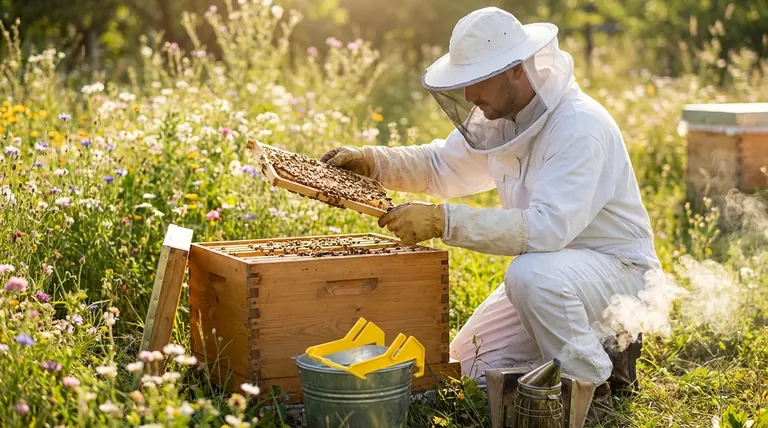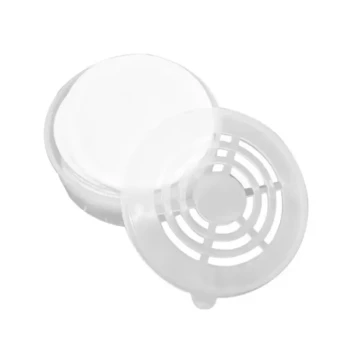For new beekeepers, the consensus on protective gear is clear: begin with full protection. The standard recommendation is to fully suit up with a quality veil, a jacket or full suit, and gloves. This approach prioritizes safety and confidence over comfort and dexterity, which is critical when you are first learning to interact with a hive.
The choice of your first set of bee gear is not just about preventing stings; it's about creating a secure learning environment. Starting with comprehensive protection allows you to focus on the bees and their behavior, not your own fear, which is the foundation of confident beekeeping.

Why Full Protection is the Standard for Beginners
For an experienced beekeeper, choosing less gear is a calculated decision based on a deep understanding of bee behavior. For a beginner, comprehensive protection is an essential tool for learning.
Building Confidence Over Comfort
Feeling safe is paramount. When you aren't worried about stings, you can move slowly and deliberately, which keeps the bees calmer.
Nervous, jerky movements can trigger a defensive response from the hive. Full gear provides a psychological buffer, allowing you to remain calm and observant as you learn.
Understanding Your Sting Tolerance
As a new beekeeper, you likely do not know how your body will react to bee venom.
Starting with full protection is a sensible precaution until you understand your personal tolerance. It provides a necessary barrier, allowing you to handle bees with confidence from day one.
Protecting Critical Areas
Stings to the face—especially the eyes, nose, and lips—are particularly painful and can be dangerous.
A high-quality beekeeping veil is universally considered the most essential piece of equipment. It offers non-negotiable protection for your most sensitive areas.
Deconstructing Your First Bee Suit: Key Components
Your protective setup consists of a few key pieces. The most significant initial decision is between a full suit and a jacket.
The Veil: A Non-Negotiable
Your veil is the single most important piece of gear. It protects your head and face while providing the visibility needed to work. A good veil is an investment in your safety and ability to inspect the hive effectively.
The Core Decision: Full Suit vs. Jacket
A full bee suit is a one-piece coverall that provides maximum protection. Its primary advantage is eliminating any gap at the waist where bees could potentially enter.
A bee jacket is easier to put on and take off and can be less cumbersome in hot weather. However, you must ensure you wear thick pants and that the jacket's elastic waistband creates a secure seal.
Hand Protection: The Role of Gloves
Gloves protect your hands but inherently reduce dexterity. Most beginners start with leather or goat-skin beekeeping gloves for maximum protection.
As you gain experience, you may transition to thinner options like nitrile gloves, which offer a better feel for the frames while still providing a layer of protection. Some experienced keepers eventually work barehanded, but this is not recommended for beginners.
Understanding the Trade-offs
Every gear choice involves balancing competing priorities. Understanding these trade-offs helps you make an informed decision.
The Cost of Confidence
Full gear can feel hot, bulky, and limit your sense of touch. This is the trade-off you make for the confidence and security it provides.
Think of it as a temporary cost. The initial lack of dexterity is a small price to pay for a safe environment in which to build your fundamental skills.
The Path to Less Gear
The advice to wear full gear is a starting point, not a permanent rule.
As you become more comfortable, learn to "read" your bees, and understand their temperament, you can begin to experiment with less gear. This progression is a natural part of becoming an experienced beekeeper.
Making the Right Choice for Your Start
Your initial gear should align with your goal of learning the craft safely. Use your personal comfort level with risk as your guide.
- If your primary focus is maximum safety and peace of mind: Opt for a full, one-piece bee suit with a quality veil and durable gloves.
- If your primary focus is balancing convenience with strong protection: A high-quality bee jacket with a built-in veil, paired with thick pants and gloves, is a practical choice.
- For all beginners, regardless of suit choice: Never compromise on a quality veil; it is your most critical piece of safety equipment.
Your initial gear is a tool that empowers you to learn the art of beekeeping with focus and security.
Summary Table:
| Gear Type | Key Benefit | Consideration |
|---|---|---|
| Full Bee Suit | Maximum protection; no gaps at waist | Can be hot and bulky |
| Bee Jacket | Easier to put on/take off; cooler | Requires secure seal with pants |
| Veil | Essential protection for face and head | Non-negotiable; invest in quality |
| Gloves | Protects hands from stings | Reduces dexterity; start with leather |
Ready to Start Your Beekeeping Journey with Confidence?
Equip yourself with the right protective gear from the beginning. HONESTBEE supplies commercial apiaries and beekeeping equipment distributors with the high-quality, durable gear needed for safe and effective hive management. Our wholesale-focused operations ensure you get reliable equipment that protects your investment—your bees and your beekeepers.
Contact HONESTBEE today to discuss your protective gear needs and build a safer, more confident beekeeping operation.
Visual Guide

Related Products
- Yellow Plastic Bucket Pail Perch for Beekeeping
- Wholesales Dadant Size Wooden Bee Hives for Beekeeping
- Long Langstroth Style Horizontal Top Bar Hive for Wholesale
- Professional Insulated Plastic Bee Hives
- Acrylic Lid Beekeeping Honey Extractor for Beekeepers
People Also Ask
- Why is proper beekeeping equipment important? Essential for Safety and Hive Health
- What does every bee keeper need? Your Essential Guide to Starting Strong
- What is the best place to keep bees? Find the Perfect Apiary Site for Your Hives
- Why is it important for beekeepers to wear protective clothing? Ensure Safety & Confidence
- What are the essential pieces of equipment for most beekeepers? Get Started with the Right Gear



















